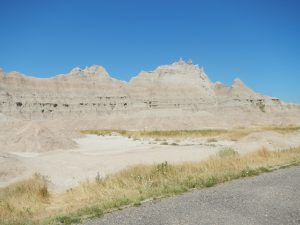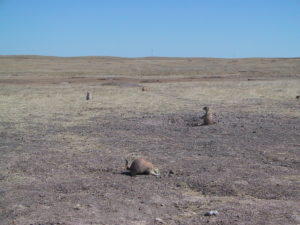Carvings, Caves, and…Corn?
We Bet You Didn't Know All of These 8 Things About South Dakota

South Dakota is often referred to as “The Mount Rushmore State”, which is a bit more on-the-nose than most state nicknames. Luckily, it is also known as “The Swinged Cat State”. When asked about his state, South Dakota’s first governor replied that it’s “[Like] a swinged cat; better than she looks.” Here are eight other facts you may not have known about the lower Dakota.

1. Mount Rushmore Has Some Competition
The iconic monument to our forefathers stands as one of the largest sculptures ever created, though there is a project underway a mere 13 miles from this landmark that, when finished, could very well claim the title of largest stone sculpture in the world. Construction on the Crazy Horse Memorial began all the way back in 1948, shortly after the completion of Mount Rushmore.

The ambitious venture – which is largely dependent on charitable donations – would serve as a tribute to the legendary Lakota warrior who fought in the Battle of Little Bighorn, as well as help preserve the legacy of North American Indians. Etched out of pegmatite granite in the Black Hills of South Dakota, the estimated dimensions of the carving upon completion would be roughly 563 high by 641 feet long, which would dwarf the presidential likenesses of Mount Rushmore, which stand at 60 feet in height.

2. It’s Home to the 3rd Longest Cave in the World
Located in the Black Hills, Jewel Cave was discovered in 1900 by a pair of local prospectors, Frank and Albert Michaud, who unsuccessfully attempted to turn their find into a tourist attraction. It wasn’t until 1939, when the National Park Service began offering tours, that the cave would begin to garner interest among the public. For many years the cave was thought to be two miles long, but in the ensuing years explorers have gone on to map more than 200 miles of passageways, making it the third-longest cave in the world, behind only Kentucky’s Mammoth Cave and Sistema Sac Actun (Spanish for “White Cave System”) on the Yucatan Peninsula of Mexico.

3. Sioux Falls was Once the Divorce Capital of the Nation
Back in the late 1800s/early 1900s, most states would not grant a divorce unless the unhappy couple had been residents for at least one year, and the only acceptable grounds for which to seek a dissolution of marriage was adultery. In contrast, South Dakota’s residency requirement was a scant three to six months, while offering six grounds on which to seek a divorce. Consequently, this led to an influx of new residents and generated more than $100,000 during that time period. From 1889 until 1909 it’s estimated that more than 6,000 divorces were granted in Sioux Falls, and that nearly two-thirds of the parties involved arrived from out of state.

4. They Celebrate Potato Day
The small town of Clark proudly proclaims itself “The Potato Capital of South Dakota”, honoring its chief crop with an annual event known as Potato Days. Each year the townspeople turn out for a festival that celebrates the spud with activities such as cooking contests and prizes for the best-decorated potato. Its most well-known event, though, would have to be mashed potato wrestling, which pits grapplers against one another in a tub full of pulverized potatoes. Overall, the event is said to be very ap-peeling.

5. Dinosaurs and Fossils! Oh My!
Over the years, South Dakota has become somewhat of a destination for fossil hunters and amateur archeologists. At Badlands National Park alone, fossils have been unearthed that date back as far as 35 million years. Some of these impressions provide the only trace of the existence of long-extinct species such as three-toed horses and creodonts – carnivorous animals with long, low skulls that died off more than 11 million years ago.

Another find near the Badlands has become one of the most well-known dinosaur discoveries of the past half-century: Sue the T. Rex. Named after Sue Hendrickson, the explorer who located the remains, Dino-Sue stands more than 12 feet high and an impressive 42 feet long. It is thought to be the largest and most complete Tyrannosaurus Rex specimen ever found, and today remains a permanent and popular resident of Chicago’s Field Museum.

6. Rodeo is the Official State Sport
Baseball may be America’s pastime, but in South Dakota the sport of choice involves bulls rather than balls. In 2003, South Dakota joined Florida, Wyoming, and Texas as the only states to designate the rodeo as the official state sport. The origins of the competitive rodeo can be traced through several countries and cultures and include events that test skill and speed, from bull riding to calf roping. It remains a signature event in the American West and is also quite popular in Canada, which has been holding its own rodeos since the dawn of the 20th century.

7. It’s Home to a Palace Decorated with…Corn?
Mitchell Corn Palace, which purports itself to be “The World’s Only Corn Palace”, has been in operation since 1892. It is one of many crop palaces that, well, cropped up toward the end of the 19th century as a means for regions to promote their agricultural products. The exterior of the palace – which has been rebuilt several times over the years (most recently in 1937) – is decorated with corn murals that are replaced each year to convey a new theme and showcase the work of local artists. The palace is such a popular destination its website offers a 24 hour “corn cam”, while concerts have even been held on the grounds featuring acts such as The Beach Boys, Johnny Cash, and Weird Al Yankovic.

8. Prairie Dogs Live Here Too – Lots of ‘em
Roberts Prairie Dog Town, located in and around (and assuredly under) Badlands National Park, is one of the largest prairie dog settlements in the country. This particular “town”, or series of interconnected burrows, is estimated to cover somewhere around 20,000 square miles and houses more than 400 million black-tailed prairie dogs. The cute little critters are seen as a pest by ornery farmers, though their presence is vital to maintaining the area’s ecosystem.




